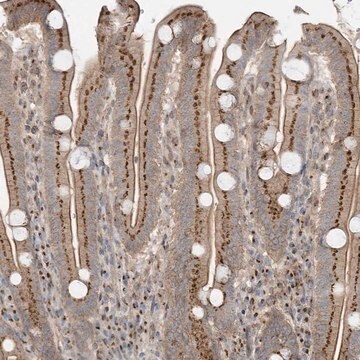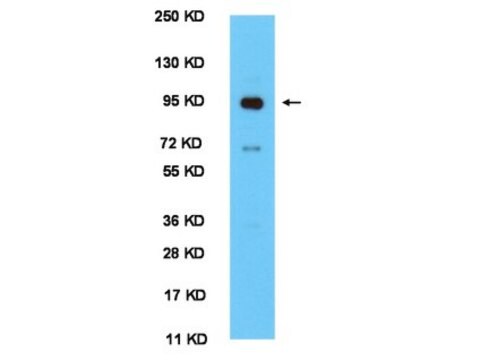MABF3068
Anti-CD163 Antibody, clone MAC2-158
Sinonimo/i:
Scavenger receptor cysteine-rich type 1 protein M130;Hemoglobin scavenger receptor
About This Item
Prodotti consigliati
Origine biologica
mouse
Livello qualitativo
Coniugato
unconjugated
Forma dell’anticorpo
purified antibody
Tipo di anticorpo
primary antibodies
Clone
MAC2-158, monoclonal
PM
calculated mol wt 125.45 kDa
Purificato mediante
using protein G
Reattività contro le specie
human
Confezionamento
antibody small pack of 100 μg
tecniche
flow cytometry: suitable
immunocytochemistry: suitable
immunohistochemistry (formalin-fixed, paraffin-embedded sections): suitable
immunoprecipitation (IP): suitable
western blot: suitable
Isotipo
IgG1κ
Sequenza dell’epitopo
N-terminal
N° accesso ID proteina
N° accesso UniProt
Condizioni di spedizione
ambient
modifica post-traduzionali bersaglio
unmodified
Descrizione generale
Specificità
Immunogeno
Applicazioni
Evaluated by Immunohistochemistry (Paraffin) in human thymus tissue sections.
Immunohistochemistry (Paraffin) Analysis: A 1:250 dilution of this antibody detected CD163 in human thymus tissue sections.
Tested Applications
Immunohistochemistry (Paraffin) Analysis: A 1:250 dilution from a representative lot detected CD163 in human liver tissue sections.
Flow Cytometry Analysis: A representative lot detected CD163 in Flow Cytometry applications Maniecki, M.B., et al. (2011). Immunobiology. 216(8): 882-90; Krijgsman, D., et al. (2020). Int J Mol Sci. 21(16): 5925).
Immunocytochemistry Analysis: A representative lot detected CD163 in Immunocytochemistry applications (Maniecki, M.B., et al. (2011). Immunobiology. 216(8): 882-90).
Flow Cytometry Analysis: A representative lot detected CD163 in human peripheral blood mononuclear cells (PBMC) (Data courtesy of Jane Collins, Research Laboratory Manager of Dr. Paul M. Guyre s Lab, Department of Microbiology and Immunology, Geisel School of Medicine, Dartmouth College, NH, USA).
Western Blotting Analysis: A representative lot detected CD163 in Western Blotting applications (Maniecki, M.B., et al. (2011). Immunobiology. 216(8): 882-90).
Immunoprecipitation Analysis: A representative lot immunoprecipitated CD163 in Immunoprecipitation applications (Morganelli, P.M., et al. (1988). J Immunol. 140(7): 2296-304).
Note: Actual optimal working dilutions must be determined by end user as specimens, and experimental conditions may vary with the end user
Stato fisico
Stoccaggio e stabilità
Altre note
Esclusione di responsabilità
Non trovi il prodotto giusto?
Prova il nostro Motore di ricerca dei prodotti.
Codice della classe di stoccaggio
12 - Non Combustible Liquids
Classe di pericolosità dell'acqua (WGK)
WGK 1
Certificati d'analisi (COA)
Cerca il Certificati d'analisi (COA) digitando il numero di lotto/batch corrispondente. I numeri di lotto o di batch sono stampati sull'etichetta dei prodotti dopo la parola ‘Lotto’ o ‘Batch’.
Possiedi già questo prodotto?
I documenti relativi ai prodotti acquistati recentemente sono disponibili nell’Archivio dei documenti.
Il team dei nostri ricercatori vanta grande esperienza in tutte le aree della ricerca quali Life Science, scienza dei materiali, sintesi chimica, cromatografia, discipline analitiche, ecc..
Contatta l'Assistenza Tecnica.








